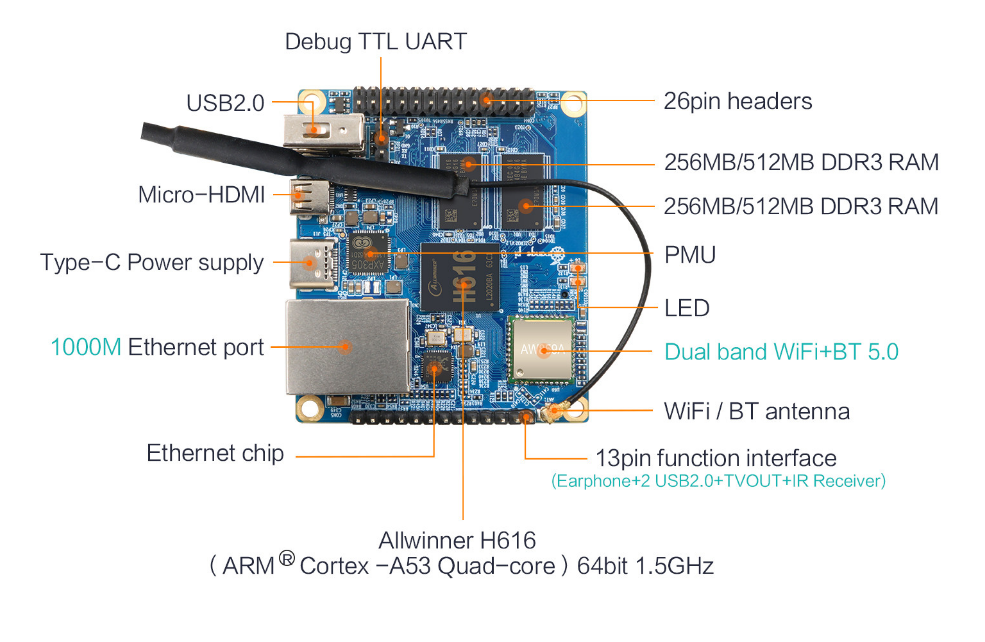Orange Pi Zero2: Small, Powerful, Cost Effective
From zero to hero

The world of single board computers (SBC) is dominated by the Raspberry Pi, but there are alternatives. The Orange Pi Zero2 is a $16 64-bit quad core Arm powered single board computer (SBC) and despite its diminutive size it has plenty of features. With enough power for multimedia, home servers and robotics projects using Ubuntu, Debian operating systems along with support for Android 10.


- SoC – Allwinner H616 64-bit quad-core Arm Cortex-A53 processor @ up to 1.5 GHz with Arm Mali G31 MP2 GPU
- Memory – 512MB or 1GB DDR3
- Storage – MicroSD card slot
- Wired Networking - Gigabit Ethernet
- Wireless Networking - Dual-band 802.11 b/g/n/ac WiFi 5 + Bluetooth 5.0
- USB – 1x USB 2.0 host port, 2x USB 2.0 interfaces via 13-pin header
- 13-pin header with 2x USB, analog stereo audio output, CVBS video output, IR input, 3x GPIOs
- 26-pin IO header with I2C, SPI, UART, multiple GPIOs
- Debugging – 3-pin UART header for serial console
- Power Supply – USB Type-C port 5V
- Dimensions – 2.3 x 2 inches (60 x 53 mm)
A quad core, 64-bit Arm Cortex A53 running at up to 1.5GHz powers the Orange Pi Zero2. A respectable amount of CPU power given the size. Add 512MB or 1GB of DDR3 RAM and support for 4K60 decoding (AVS2, H265/HEVC and VP9) and 4k30 decoding (H264) and Orange Pi Zero2 could be a powerful multimedia platform which can be easily embedded into a project such as kiosks, art installations and digital signage.
WiFi and Bluetooth 5.0 connectivity is provided via an Allwinner AW859A wireless module, an established module used in other devices such as the X96Q MAX. An external antenna will hopefully provide good connections.
There are a series of GPIO pins on the Orange Pi Zero2. The largest is the 26 pin IO header which serves as the main GPIO access point. Here we can make digital IO connections or use protocols such as I2C, SPI and UART. The GPIO is typically available via the terminal, where we can control and read the pin state as if the GPIO were a typical device. It is not known if the GPIO will be supported by other languages via packages and modules, for example on of the many forks of the RPi.GPIO Python package. This is one of the key differences between Raspberry Pi and other SBC. With the Pi we know that there will be support and documentation for key languages.
A 13 pin GPIO, next to the Ethernet port provides additional USB, analog audio, video output and three extra GPIO pins.
Supported operating systems are Android 10, Ubuntu and Debian Linux. At this time there is little information on software and general documentation which is surprising as this board was announced quite some time ago.
With a $15.99 starting price for a 512MB model and only $3 more for 1GB, the Orange Pi Zero2 is right in the sweet spot occupied by the Raspberry Pi Zero W. But with the Orange Pi Zero 2 we have much more power in only a slightly bigger package. If you are a confident SBC user then this board may just be the one for you.
Get Tom's Hardware's best news and in-depth reviews, straight to your inbox.

Les Pounder is an associate editor at Tom's Hardware. He is a creative technologist and for seven years has created projects to educate and inspire minds both young and old. He has worked with the Raspberry Pi Foundation to write and deliver their teacher training program "Picademy".
-
Bohio Hello , Is the GPIO compatible with RaspberyPI ( even is not same phical position ) ?Reply
Thanks